display Alfa Romeo MiTo 2012 Owner handbook (in English)
[x] Cancel search | Manufacturer: ALFA ROMEO, Model Year: 2012, Model line: MiTo, Model: Alfa Romeo MiTo 2012Pages: 262, PDF Size: 6.46 MB
Page 113 of 262
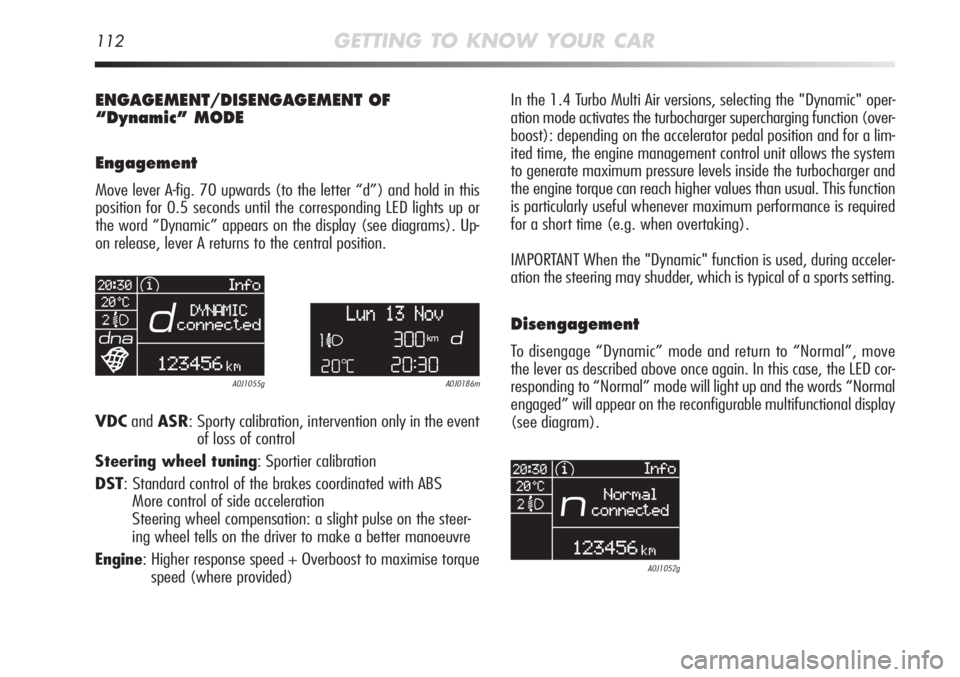
112GETTING TO KNOW YOUR CAR
ENGAGEMENT/DISENGAGEMENT OF
“Dynamic” MODE
Engagement
Move lever A-fig. 70 upwards (to the letter “d”) and hold in this
position for 0.5 seconds until the corresponding LED lights up or
the word “Dynamic” appears on the display (see diagrams). Up-
on release, lever A returns to the central position.
Disengagement
To disengage “Dynamic” mode and return to “Normal”, move
the lever as described above once again. In this case, the LED cor-
responding to “Normal” mode will light up and the words “Normal
engaged” will appear on the reconfigurable multifunctional display
(see diagram).
A0J0186mA0J1055g
A0J1052g
VDCandASR: Sporty calibration, intervention only in the event
of loss of control
Steering wheel tuning: Sportier calibration
DST: Standard control of the brakes coordinated with ABS
More control of side acceleration
Steering wheel compensation: a slight pulse on the steer-
ing wheel tells on the driver to make a better manoeuvre
Engine: Higher response speed + Overboost to maximise torque
speed (where provided)In the 1.4 Turbo Multi Air versions, selecting the "Dynamic" oper-
ation mode activates the turbocharger supercharging function (over-
boost): depending on the accelerator pedal position and for a lim-
ited time, the engine management control unit allows the system
to generate maximum pressure levels inside the turbocharger and
the engine torque can reach higher values than usual. This function
is particularly useful whenever maximum performance is required
for a short time (e.g. when overtaking).
IMPORTANT When the "Dynamic" function is used, during acceler-
ation the steering may shudder, which is typical of a sports setting.
Page 114 of 262
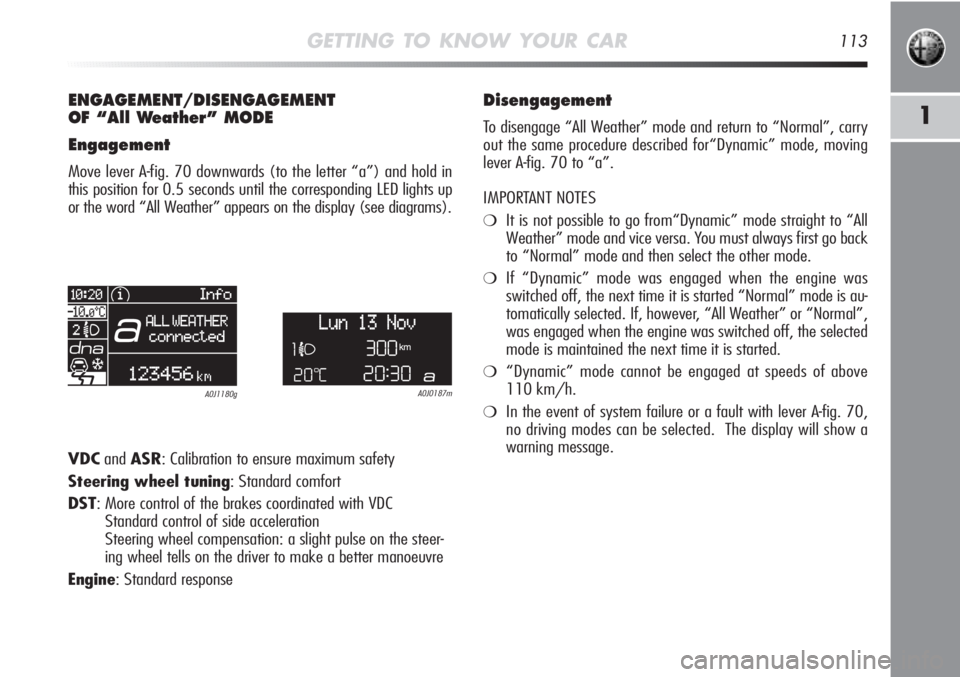
GETTING TO KNOW YOUR CAR113
1
ENGAGEMENT/DISENGAGEMENT
OF “All Weather” MODE
Engagement
Move lever A-fig. 70 downwards (to the letter “a”) and hold in
this position for 0.5 seconds until the corresponding LED lights up
or the word “All Weather” appears on the display (see diagrams).
A0J0187mA0J1180g
Disengagement
To disengage “All Weather” mode and return to “Normal”, carry
out the same procedure described for“Dynamic” mode, moving
lever A-fig. 70 to “a”.
IMPORTANT NOTES
❍It is not possible to go from“Dynamic” mode straight to “All
Weather” mode and vice versa. You must always first go back
to “Normal” mode and then select the other mode.
❍If “Dynamic” mode was engaged when the engine was
switched off, the next time it is started “Normal” mode is au-
tomatically selected. If, however, “All Weather” or “Normal”,
was engaged when the engine was switched off, the selected
mode is maintained the next time it is started.
❍“Dynamic” mode cannot be engaged at speeds of above
110 km/h.
❍In the event of system failure or a fault with lever A-fig. 70,
no driving modes can be selected. The display will show a
warning message.
VDCandASR: Calibration to ensure maximum safety
Steering wheel tuning: Standard comfort
DST: More control of the brakes coordinated with VDC
Standard control of side acceleration
Steering wheel compensation: a slight pulse on the steer-
ing wheel tells on the driver to make a better manoeuvre
Engine: Standard response
Page 115 of 262

114GETTING TO KNOW YOUR CAR
NoteThe engine automatic stop is allowed only after having run
at about 10 km/h, to prevent repeated engine stops when driving
at a very slow speed. The engine stopping is signalled by display-
ing the
Usymbol in fig. 71.
Engine re-starting mode
To restart the engine, press the clutch pedal.
SYSTEM MANUAL ACTIVATION/DEACTIVATION
To activate/deactivate the system, press the button fig. 72 on
the trim next to the steering wheel. When the system is deacti-
vated, the
Uwarning light in the instrument panel switches on.
For versions/markets, where fitted, a message plus a symbol on
the display may appear in the event of activation/deactivation of
the system.
START&STOP SYSTEM
(for versions/markets, where provided)
The Start&Stop system stops the engine automatically when the
vehicle stops and starts it again when the driver wants to resume
driving. In this way, the vehicle efficiency is increased, by reduc-
ing consumption, dangerous gas emissions and sound pollution.
The system is active every time the engine is started.
OPERATING MODE
Engine stopping mode
With stopped vehicle, the engine stops with gearbox in neutral and
released clutch pedal.
fig. 71A0J0279mfig. 72A0J0247m
Page 116 of 262
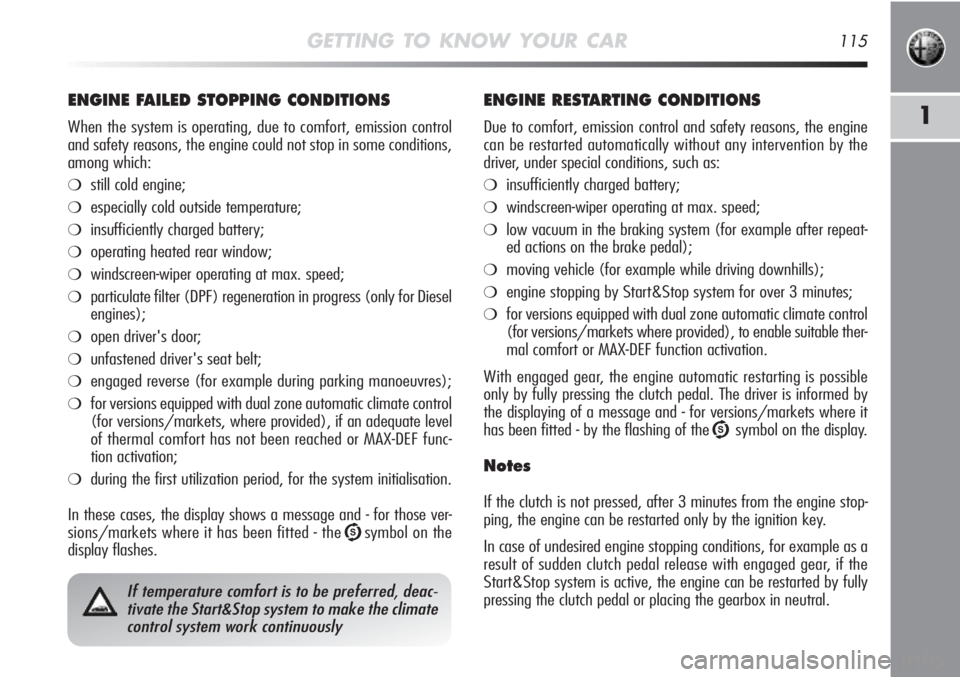
GETTING TO KNOW YOUR CAR115
1
ENGINE FAILED STOPPING CONDITIONS
When the system is operating, due to comfort, emission control
and safety reasons, the engine could not stop in some conditions,
among which:
❍still cold engine;
❍especially cold outside temperature;
❍insufficiently charged battery;
❍operating heated rear window;
❍windscreen-wiper operating at max. speed;
❍particulate filter (DPF) regeneration in progress (only for Diesel
engines);
❍open driver's door;
❍unfastened driver's seat belt;
❍engaged reverse (for example during parking manoeuvres);
❍for versions equipped with dual zone automatic climate control
(for versions/markets, where provided), if an adequate level
of thermal comfort has not been reached or MAX-DEF func-
tion activation;
❍during the first utilization period, for the system initialisation.
In these cases, the display shows a message and - for those ver-
sions/markets where it has been fitted - the
Usymbol on the
display flashes.
ENGINE RESTARTING CONDITIONS
Due to comfort, emission control and safety reasons, the engine
can be restarted automatically without any intervention by the
driver, under special conditions, such as:
❍insufficiently charged battery;
❍windscreen-wiper operating at max. speed;
❍low vacuum in the braking system (for example after repeat-
ed actions on the brake pedal);
❍moving vehicle (for example while driving downhills);
❍engine stopping by Start&Stop system for over 3 minutes;
❍for versions equipped with dual zone automatic climate control
(for versions/markets where provided), to enable suitable ther-
mal comfort or MAX-DEF function activation.
With engaged gear, the engine automatic restarting is possible
only by fully pressing the clutch pedal. The driver is informed by
the displaying of a message and - for versions/markets where it
has been fitted - by the flashing of the
Usymbol on the display.
Notes
If the clutch is not pressed, after 3 minutes from the engine stop-
ping, the engine can be restarted only by the ignition key.
In case of undesired engine stopping conditions, for example as a
result of sudden clutch pedal release with engaged gear, if the
Start&Stop system is active, the engine can be restarted by fully
pressing the clutch pedal or placing the gearbox in neutral.
If temperature comfort is to be preferred, deac-
tivate the Start&Stop system to make the climate
control system work continuously
Page 117 of 262

116GETTING TO KNOW YOUR CAR
SAFETY CONDITIONS
When the engine is stopped by the Start&Stop system, if the dri-
ver releases his/her seat belt and opens the driver's or passenger's
door, the engine can be restarted only by the ignition key.
This condition is signalled by a buzzer and by a displayed message
and - for versions/markets where it has been fitted - by the flash-
ing of the
Usymbol on the display.
"ENERGY SAVING" FUNCTION
(for versions/markets, where provided)
If, as a result of the engine automatic restarting, the driver does not
make any action on the vehicle for over 3 minutes, the Start&Stop
system stops the engine once and for all, to prevent fuel consump-
tion. In these cases, the engine can be restarted only by the igni-
tion key.
Note In any case, the engine can be still kept running by deactivat-
ing the Start&Stop system.
OPERATING IRREGULARITIES
In case of malfunctioning conditions, the Start&Stop system is
deactivated. The driver is informed about the failure through the
switching-on of the warning light
èon the instrument panel and
- for versions/markets where it has been fitted - through the dis-
playing of a message + symbol. In this case, contact Alfa Romeo
Authorised Service.
Page 125 of 262

124GETTING TO KNOW YOUR CAR
INDICATIONS ON DISPLAY
(for versions/markets where provided)
When the sensor is activated, the "Reconfigurable multifunctional
display" (for versions/markets where provided) shows the screen
illustrated in fig. 81; the information about the presence of and
distance from the obstacle is given by the buzzer and also by a
visual indication on the instrument panel display. If there are
several obstacles the closest one is indicated.
BUZZER WARNINGS
When reverse gear is engaged a buzzer warning is automatically
activated if there is an obstacle within the range of operation. The acoustic signal:
❍becomes louder as the distance between the car and the obsta-
cle decreases;
❍becomes continuous when the distance between the car and
the obstacle is less than 30 cm and stops immediately if the
distance increases;
❍is constant if the distance is unchanged; if this situation con-
cerns the side sensors, the buzzer will stop after about 3 sec-
onds to avoid, for example, warning indications in the event of
manoeuvres along walls.
IMPORTANT The volume of the audible signal can be adjusted
through the option "Warning volume" of the "Set-Up menu".
Detection distances
Central action range: 140 cm
Side action range: 60 cm
If several obstacles are detected, the control unit indicates the near-
est one.
OPERATION WITH TRAILER
Parking sensor operation is deactivated automatically when the
trailer electric cable plug is fitted into the car tow hook socket.
The sensors are automatically enabled again when the trailer ca-
ble plug is removed.
fig. 81A0J0370m
Page 127 of 262

126GETTING TO KNOW YOUR CAR
T.P.M.S. SYSTEM
(Tyre Pressure Monitoring System)
(for versions/markets, where provided)
The vehicle can be fitted with a tyre pressure monitoring system
(T.P.M.S.), which informs the driver of the tyre inflation pressure
via the “Check the tyre inflation pressure” and “Insufficient tyre in-
flation pressure” warning messages.
This system comprises of a radio frequency transmitter fitted to
each wheel (on the wheel rim inside the tyre), which is able to
send information on the tyre inflation pressure of each wheel to
the control unit.
IMPORTANT NOTES ABOUT
THE T.P.M.S. SYSTEM
The fault indications are not stored and will therefore not be dis-
played after the engine has been switched off and then on again.
If the fault conditions persist, the control unit will send fault infor-
mation to the instrument panel only after the vehicle has been in
motion for a short time.
Take the greatest of care when checking and top-
ping up the tyre inflation pressure. Excessive pres-
sure compromises road holding, increases the stress
on the suspension and wheels as well as increasing the risk
of the tyres wearing out un-evenly.
The tyre inflation pressure should be measured
with the tyres at rest and cold; if for any reason
the pressure is checked when the tyres are warm,
do not reduce the pressure if it is excessive but rather wait
until the tyres have cooled down and carry out the check
again.
The presence of the T.P.M.S. system does not mean
the driver should not carry out regular checks on
the tyre inflation pressure and spare wheel.
Should one or more wheels be fitted without sen-
sors, the display will show a warning message and
the system will no longer be available until 4
wheels fitted with sensors are fitted.
Page 128 of 262

GETTING TO KNOW YOUR CAR127
1The T.P.M.S.system is not able to detect sudden tyre
inflation pressure losses (for example when a tyre
explodes). In this case stop the car, braking with
care and avoiding sharp steering actions.
Replacing the normal tyres with winter tyres and
vice versa requires the inspection of the T.P.M.S.
system, which should only be carried out by an Al-
fa Romeo Authorised Service.
The T.P.M.S. system requires the use of specific equip-
ment. Contact an Alfa Romeo Authorised Service to
find out which accessories are compatible with the
system (wheels, hub caps etc.). The use of other accessories
may affect the normal operation of the system.
When a tyre is removed, it is advisable to replace
the rubber gasket for the valve. Contact an Alfa
Romeo Authorised Service. Tyre and wheel fit-
ting/removal operations require specific precautions; to
avoid damaging or fitting the sensors incorrectly, tyre and
wheel fitting/removal operations should only be carried
out by specialists. Contact an Alfa Romeo Authorised Ser-
vice Provider.
Strong radio frequency disturbance can compro-
mise the correct operation of the T.P.M.S. system.
The driver is warned of this condition via a mes-
sage on the display. The warning message will go off au-
tomatically as soon as the radio-frequency noise ceases to
disturb the system.
Tyre inflation pressure can vary according to out-
door temperature. The T.P.M.S. system may tem-
porarily indicate insufficient pressure. In this case
check the tyre inflation pressure with the tyres cold and,
if necessary top up the inflation pressure.
Page 134 of 262
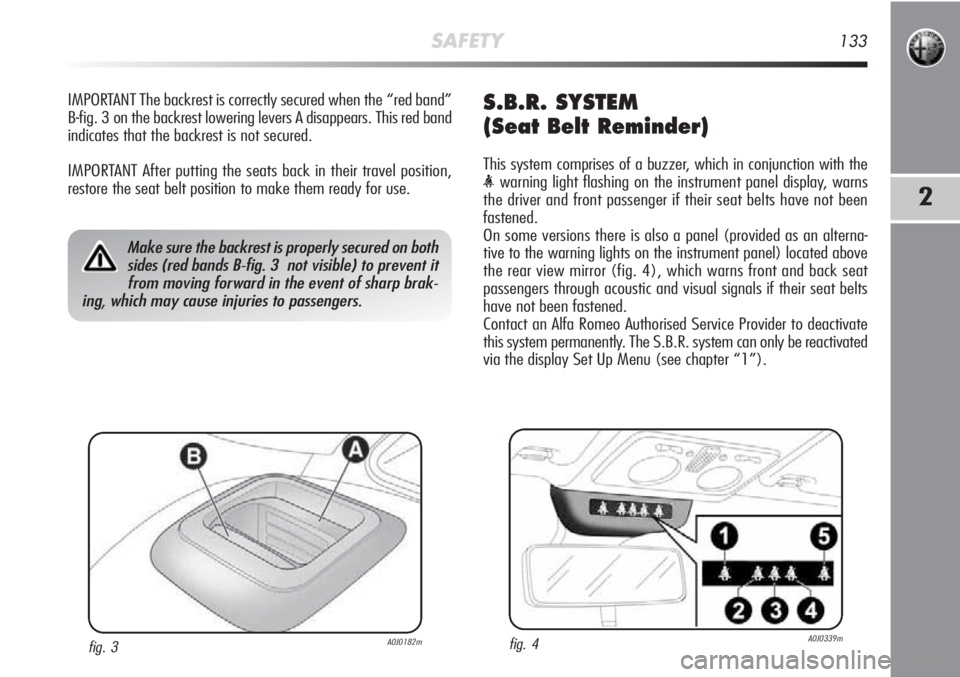
SAFETY133
2
IMPORTANT The backrest is correctly secured when the “red band”
B-fig. 3 on the backrest lowering levers A disappears. This red band
indicates that the backrest is not secured.
IMPORTANT After putting the seats back in their travel position,
restore the seat belt position to make them ready for use.S.B.R. SYSTEM
(Seat Belt Reminder)
This system comprises of a buzzer, which in conjunction with the
fastened.
On some versions there is also a panel (provided as an alterna-
tive to the warning lights on the instrument panel) located above
the rear view mirror (fig. 4), which warns front and back seat
passengers through acoustic and visual signals if their seat belts
have not been fastened.
Contact an Alfa Romeo Authorised Service Provider to deactivate
this system permanently. The S.B.R. system can only be reactivated
via the display Set Up Menu (see chapter “1”).
Make sure the backrest is properly secured on both
sides (red bands B-fig. 3 not visible) to prevent it
from moving forward in the event of sharp brak-
ing, which may cause injuries to passengers.
fig. 4A0J0339mfig. 3A0J0182m
Page 135 of 262
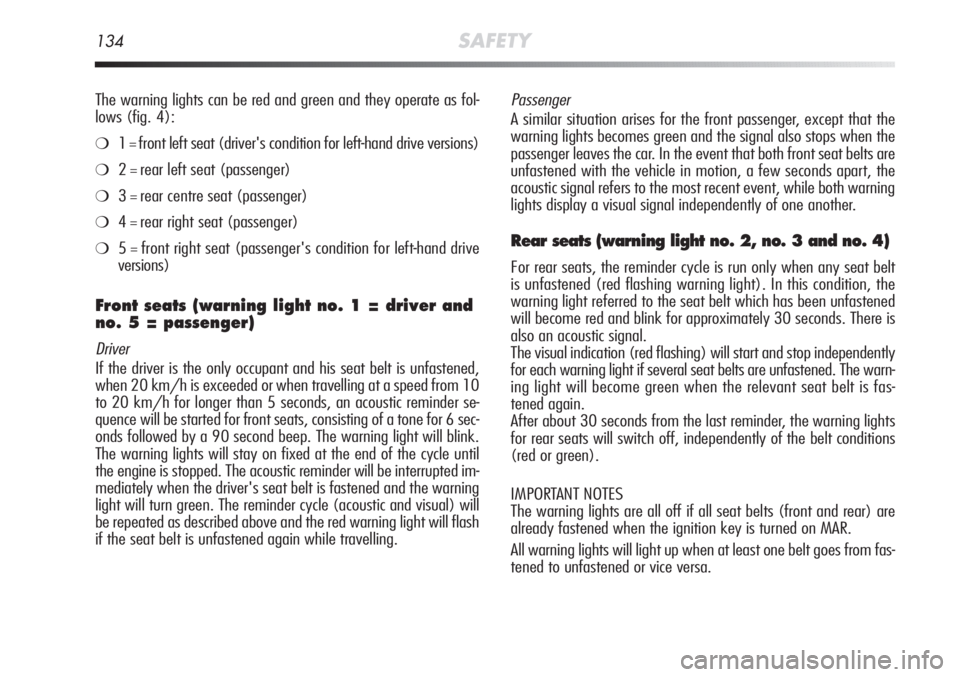
134SAFETY
The warning lights can be red and green and they operate as fol-
lows (fig. 4):
❍1=front left seat (driver's condition for left-hand drive versions)
❍2=rear left seat (passenger)
❍3=rear centre seat (passenger)
❍4=rear right seat (passenger)
❍5=front right seat (passenger's condition for left-hand drive
versions)
Front seats (warning light no. 1 = driver and
no. 5 = passenger)
Driver
If the driver is the only occupant and his seat belt is unfastened,
when 20 km/h is exceeded or when travelling at a speed from 10
to 20 km/h for longer than 5 seconds, an acoustic reminder se-
quence will be started for front seats, consisting of a tone for 6 sec-
onds followed by a 90 second beep. The warning light will blink.
The warning lights will stay on fixed at the end of the cycle until
the engine is stopped. The acoustic reminder will be interrupted im-
mediately when the driver's seat belt is fastened and the warning
light will turn green. The reminder cycle (acoustic and visual) will
be repeated as described above and the red warning light will flash
if the seat belt is unfastened again while travelling.
Passenger
A similar situation arises for the front passenger, except that the
warning lights becomes green and the signal also stops when the
passenger leaves the car. In the event that both front seat belts are
unfastened with the vehicle in motion, a few seconds apart, the
acoustic signal refers to the most recent event, while both warning
lights display a visual signal independently of one another.
Rear seats (warning light no. 2, no. 3 and no. 4)
For rear seats, the reminder cycle is run only when any seat belt
is unfastened (red flashing warning light). In this condition, the
warning light referred to the seat belt which has been unfastened
will become red and blink for approximately 30 seconds. There is
also an acoustic signal.
The visual indication (red flashing) will start and stop independently
for each warning light if several seat belts are unfastened. The warn-
ing light will become green when the relevant seat belt is fas-
tened again.
After about 30 seconds from the last reminder, the warning lights
for rear seats will switch off, independently of the belt conditions
(red or green).
IMPORTANT NOTES
The warning lights are all off if all seat belts (front and rear) are
already fastened when the ignition key is turned on MAR.
All warning lights will light up when at least one belt goes from fas-
tened to unfastened or vice versa.